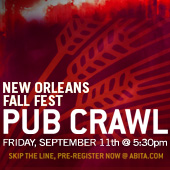…then you should check out this event. Lompoc makes some good beer. LSD is one of my personal favorites. Even the roasty smoky beer has piqued my interest.

PORTLAND, Ore. – Sept. 4, 2009 – The brewers at Lompoc Brewing are welcoming autumn with a release party of their newest seasonal, Lompoc Oktoberfest. The event will take place Sept. 11 from 4 to 9 p.m. at the Sidebar, Lompoc’s new tasting room located at 3901A N. Williams.
Staying true to the theme, the evening will feature a buffet of sausages and snacks, as well as five other specialty and barrel fermented beers, and the opportunity to mingle with the Lompoc brewers.
Pale orange in color, Lompoc Oktoberfest features a clean malt flavor artfully balanced by a touch of Perle hops. A portion of the grains used was roasted in the oven at Lompoc’s Fifth Quadrant restaurant, giving the beer a slight biscuity flavor. The beer is 5% ABV and 15 IBUs. Lompoc Oktoberfest will be on draft in all five of Lompoc’s pubs beginning Sept. 14.
Party attendees will also have the opportunity to preview tasters of Monster Mash, Lompoc’s Halloween seasonal. An imperial porter, Monster Mash is a dark ale with strong chocolate and roast flavors and a touch of red fruit. It weighs in at 8% ABV and 50 IBUs.
Other beers on the menu include Smoked Gold, a twist on the brewery’s popular Fool’s Gold that includes the addition of beechwood smoked malt for a subtle note of wood smoke (4.6% ABV, 16 IBU); Flower of the Gods IPA, a summer seasonal hopped with Simcoe and Tettnangers for a slight citrus flavor followed by a spicy finish (6.4% ABV, 60 IBU); Barrel Fermented Red, Lompoc’s Proletariat Red 100% fermented in a vintage white English oak barrel for a malty and full bodied ale with a deep, rich red color and a slight touch of oak (6.2% ABV, 45 IBU); and Bourbon Barrel Aged LSD, a deep mahogany strong ale crafted with seven specialty malts, then aged in bourbon barrels for three months and cellared for an additional 10 (6.9% ABV, 58 IBU).






